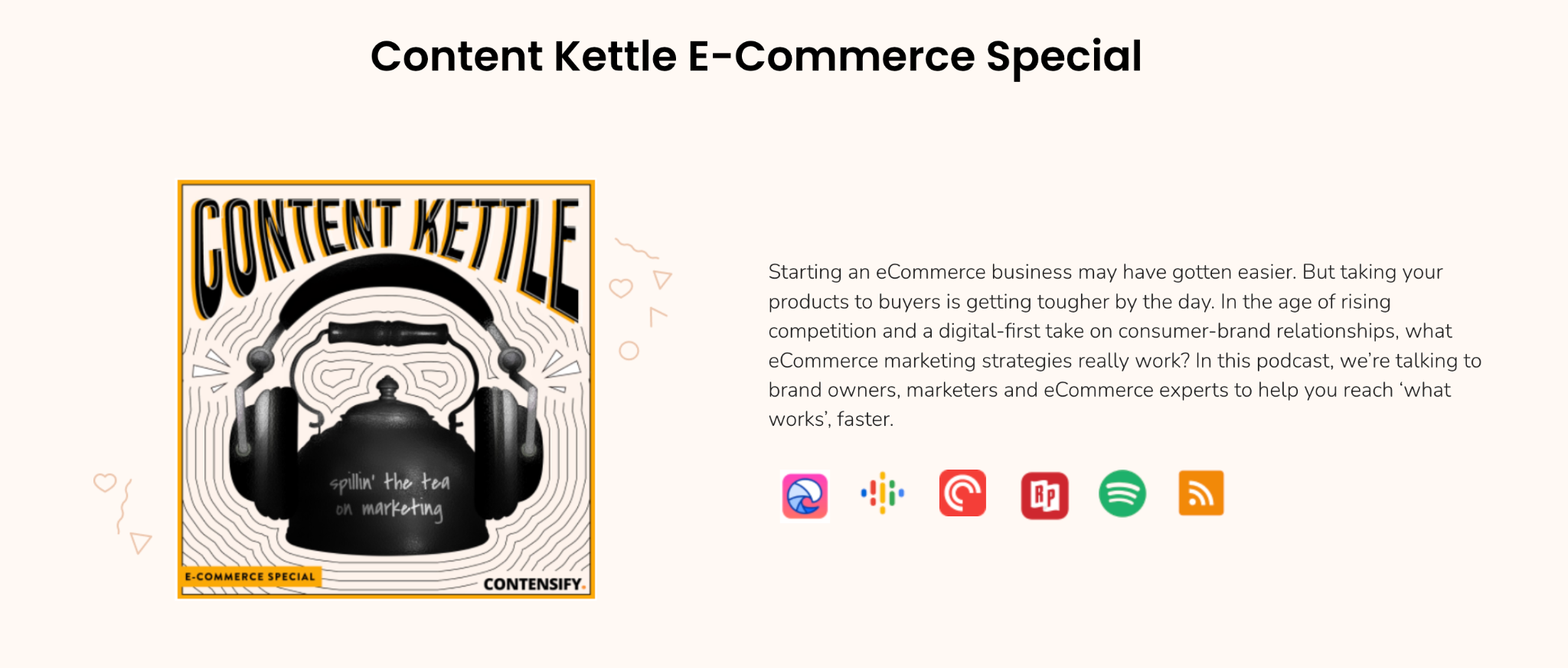Learn how to diversify your B2B content marketing mix.
“Content is king” is a phrase many would’ve come across when it comes to marketing. This holds true now more than ever, as content has overtaken traditional marketing methods as the best way to garner your customer’s attention. While content has been broadly accepted by marketers nowadays, it has become challenging to make your content stand out and convert readers into customers.
Maintaining the interest of your audience and keeping them hooked to your content in this age of multi-platform media is highly critical. You must learn to experiment with your branded content and navigate on different platforms to achieve online success.
Developing a diverse content strategy is crucial in today’s supersaturated, dynamic and competitive marketing setting. If your marketing strategy relies hugely on branded content, make sure that it is diverse in terms of when, where and how it is shared. If you use the same content and formats across all platforms, the audience will lose interest, and you’ll lose engagement.
Why should you diversify your content marketing mix?
As they say, variety is the spice of life, and the same is true for an effective content marketing strategy. Different audiences engage with different formats of content on different platforms. So, when you diversify and mix up your strategy, you keep your current audiences excited and attract new audiences.
We all know that producing better content beats everything, but creating top-notch content is imperative to stand out from competitors. But there’s one aspect that seems hard to achieve: diversity.
Diversifying your content strategy means having a wide range of topics and posts using different social media platforms. The more diverse your strategy, the more likely your audience will be engaged and the wider variety of people you’ll be able to reach. All you need is “out of the box thinking,” redefining your practices, and stepping out of your comfort zone.
Diversifying your content strategy has several advantages, including:
- It spurs your team’s creativity breathing fresh air into your marketing routine.
- You are motivated to try new tools and create new resources.
- Expanding your content formats and media will help you understand your audience better.
- Utilizing more formats can increase the number of channels you can use. New formats can be turned into powerful lead magnets, bringing you new sign-ups and leads.
This article will examine why diversifying your content marketing mix should be your next step for content success. Here are a few easy ways to diversify your content strategy and draw the audience’s attention without disturbing the magic you’ve already created.
9 Ideas to Diversify your Content Marketing Strategy
For a successful content marketing strategy, it’s crucial to implement the change from the inside out rather than just giving into the latest marketing trends and pouring umpteen amounts of time, effort, and funds into adopting them.
Diversifying your workforce allows your business to keep a broad perspective that can span age, culture, gender, and other industry-specific demographic. Diversity in the workplace increases efficiency and innovation as the healthy difference in perspectives that each team member brings to the table will facilitate maintaining a diverse marketing strategy.
1. Social Media Diversification
Social media is one of the most critical marketing strategies for generating online traffic. It allows you to avoid an over-dependence on organic and paid traffic from search engines.
A firm hold on social media enables you to engage with your existing customer base and leverage it to find more followers. However, ensure that you mindfully invest in the social media platforms used by your customers.

Different content formats are perfect for diversifying content marketing strategies and making them more efficient. Diversifying your content doesn’t necessarily mean creating fresh content every time; instead, it’s all about using innovative ways to deliver your content in a new format and engage more with audiences.
2. Personalize Your Content
In the oversaturated world of content marketing, it is getting harder by the day to attract your audience’s attention using generic content. But, by tailoring and personalizing your content, you are more likely to engage your targeted customers. 86% of marketers say they have seen a quantifiable increase in business results from their personalization campaigns.
With the rising trend of content personalization, every customer has a better experience as they can quickly see what is relevant to them and determine if a product is a good fit for them. It directly influences the customer’s buying behavior with the likelihood of purchasing, recommending, and repurchasing depending on personalization, generating long-term customer value and loyalty.
Take a look at HubSpot for instance; they have personalized their content since forever based on different audience segments and how they can leverage their products.

Although it’s still a developing trend, personalization is here to stay, and it should factor into every marketer’s strategy for the future.
3. Explore long-form content.
Boost your SEO rankings and drive valuable traffic for your business by incorporating long-form content as a part of your content marketing strategy. Long-form content gives your audience more valuable and informative content giving you the potential to position yourself as an industry expert with increasing SERP rankings.

When your audience is looking for detailed information, long-form content comes to your rescue by providing valuable and in-depth knowledge that shows your expertise and positions you as a subject matter expert. But, valuable long-form content that works and stands the test of our decreasing attention spans is creating audience engagement, not the length.
Long-form content doesn’t always mean a long blog article; it can also be 30-minute podcast episodes, 15-minute YouTube tutorials, 60-minute webinars, or even long carousel posts on LinkedIn.
4. Experiment with visual content
Videos are quickly gaining command in the content marketing scene. Nowadays, many internet users prefer watching a video to reading text with the same content. 78% say that they are convinced to buy something or download an app or software by watching a video as they quickly receive precise and clear information.

Videos and live streaming can be a great lead magnet in your content campaigns, fetching the companies more qualified leads and faster revenue growth. Hence, it would be best if you often opted for this format in your content marketing strategy.
A larger audience is choosing video content over reading blogs, but this doesn’t mean you have to create new content. You can pick some of your top-performing blogs and repurpose them into videos. Here are a few ideas:
- Educational Videos: Turn your old blog posts into valuable educational video courses on topics in your niche.
- Introduction Videos: Introduce people to your business through these videos.
- Showcase Video: Create these for your products or services.
- Tutorial Videos: Educate your customers on using your products or services through videos.
- Create behind-the-scenes videos.
- Livestream the company’s events.
For example, SurveyMonkey has an amazing way of educating their target audience through videos – about best practices as well as their feature set. This has helped them get 27k subscribers on that one channel alone, becoming a key platform for boosting brand awareness.

5. Repurposing Existing Content
Repurposing existing content material instead of creating new content is always a better idea. It saves you ample time and effort, helping you reach a broader demographic.

For example, if you turn a blog post into a video to be shared on your YouTube channel, then this, in turn, can be broken into small snippets for use on social media. Similarly, you could use the audio of an online event to create a podcast for broader distribution.
To repurpose the existing content, you must consider how to present the information in different formats. You must also have a clear vision of the content’s purpose and preserve some value across the transition.
If you’re new to content repurposing, here’s a quick guide on it.
6. Start a Podcast
Podcasts, indeed, aren’t new since Apple released its podcast functionality in 2005. But in recent years, podcasts have gained traction due to their easy availability and the convenience of listening to audio content while performing other tasks.
37% of the population listens to at least one podcast each month; hence, creating a podcast as part of your content strategy podcast is a great way to connect and deliver value to your audience, who are always on the go.
Create your podcast with innovative ideas where you can interview industry leaders, share advice and tips, or even tell stories. You can also invite guests to your podcast, which will help you expand your reach and gain new audiences.
For example, we at Contensify, have a podcast called Content Kettle. The podcast is a deep dive into the minds of DTC brands and the growth strategies they use to acquire, engage and retain customers. Tune in to the episodes here.

7. Create a Whitepaper
Creating a well-researched whitepaper will help you increase your authority in your niche. A whitepaper dives deep into a subject matter of a specific topic or trend. By offering expert opinions and solutions, your business can position itself to be the best to help your customer solve the problem when it arises.
An excellent whitepaper combines the below criteria:
- It is authoritative and informative, providing verified, well-cited data
- It is concise as it uses graphs and charts to visualize and structure complicated data to make it easier to comprehend
For example, Omnisend does a fantastic job at creating industry-specific, consumer-centric and high on value whitepapers and reports.

8. Try Interactive Content
Interactive content is website content that is interactive and clickable. It encourages dynamic engagement, like filling in an online questionnaire, quiz, or questionnaire, wherein the user is part of an active two-way experience and not just a passive user of the website.
According to a survey by the Content Marketing Institute (CMI), 81% of marketers said that interactive content is more effective than static content in gaining users’ attention.
Interactive content is quickly becoming the content of choice for today’s web designers, creating the latest interactive user experience (UX) website designs.

More and more marketers include this type of content within their websites to engage with customers and ensure a good return on investment.
9. Leverage Virtual Reality
The emergence of virtual reality is the latest trend in the dynamic and ever-changing digital world. VR aims to change how companies advertise and significantly shift how consumers engage with those brands.
For example, EntropikTech is doing a great job at using VR to introduce their products that leverage advanced technologies. Their demos are more than just manual walkthroughs of the product; they have built a free version of the tool to let their target audience explore all the features and truly experience it.

Virtual reality is all set to improve the content marketing efforts of brands worldwide and engage with consumers through experiential marketing. Many brands have already incorporated VR in their content marketing strategy to provide unique experiences and achieve outstanding levels of consumer engagement.
Learn more about using VR in content marketing here.
Conclusion
With the increase in content formats, it’s safe to say that content marketing is changing dynamically. Engaging your audience only with written form of content will become increasingly difficult. Thus, diversifying your content is key!
For diversifying your content, you have to keep in mind what your target audience enjoys and not create different content styles just for the sake of it. Look at what kinds of content your target audience frequently engages with, and get creative without going overboard to draw their attention.
As you start experimenting with different content types, it’ll become easier to understand where exactly you should invest. With an accurate, diverse mix of content, you’ll soon start attracting new audiences and keep your past customers coming back for more.
Need help in diversifying your content marketing strategy?




